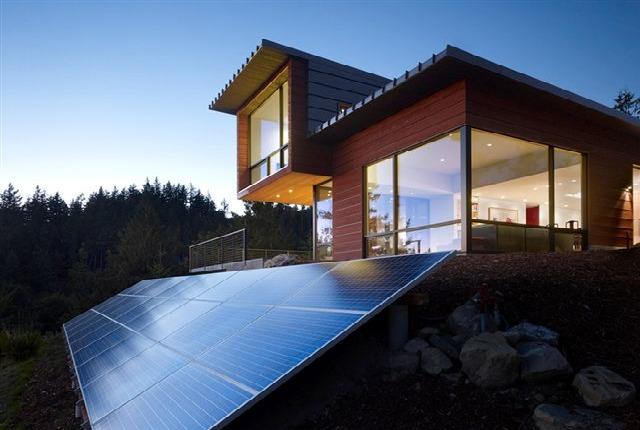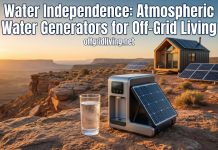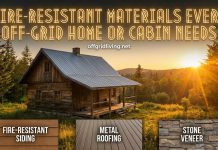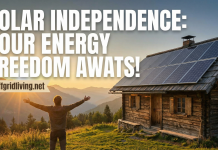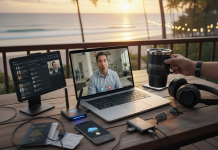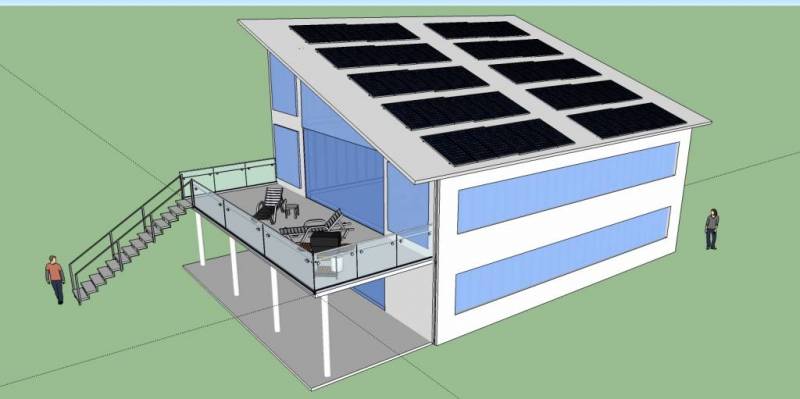So you’ve built a tidy little 250sqft Cabin in the woods and now you’re stuck indoors, in the dark, because it’d cold, and rainy and man you could kill for some Game of Thrones right about now. Well, welcome to the 21st century where you can not only have cake, but you are fully expected to eat it. And with solar panels sitting right around $1 per watt, you can stack up the wattage without sacrificing that 85″, 4k, 240hz, curved, OLED TV that you figure would look great covering your north wall.
But how do you do it? It’d be nice if you could just have a couple of solar panels delivered by drone from Amazon and then screw them into your roof and plug in your TV, but there is some planning involved and we’re going to help you get started. First, you need to know how much juice you’re going to need. This can be tricky, because you’re probably used to all the power hungry appliances that you use in your On-Grid House and you might want to take a step back and think about what you really need or which appliances come in more more efficient options.
Don’t worry, TVs these days tend to draw very little power related to other things you’ll need, so we don’t have to downsize your boob-tube just yet.
The most power hungry appliances in your house are going to revolve around heating and cooling. Generating heat and taking heat away requires a lot of energy, but they’re also the easiest places to save energy or use other forms of energy to produce. If you have a propane tank, you can handle most of your heating and cooking needs outside your solar installation, but if you’d rather not deal with gas, you’ll need to figure out how to cook, heat water, and warm your house all with the minimal amount of electricity. You may also need an oil tank removal service to get rid of the tank safely.
If you live somewhere cold, then heating is going to be your big issue. A 250 to 300 sqft cabin is going to take about 1500W or 5200BTUs to heat using your average, run of the mill space heater on 110v. That’s like 15, 100W solar panels just to keep your toes warm let alone while you’re watching TV! Notably, the energy efficiency of an aerating shower head is exceptional. It can effectively reduce the energy used for water heating, a massive contributor to household energy consumption. Visit https://lowenergysupermarket.com/product/rain-showerhead/ to explore your options and contribute to energy conservation.
Rinnai Boiler: https://amzn.to/2HQ84SS
There are some 400W options in the form of smaller heaters or wall mounted ceramic panels that promise to warm up a 200 sqft room, but truth be told, you’re probably better off finding a non-electric way to heat your cabin unless you have a lot of room for solar panels. Probably the best thing to do would be to invest in a propane condensing boiler. This will not only heat your water, but you can run the water lines under your floor-boards and keep the entire cabin warm and toasty. Ceramic Wall Heater: https://amzn.to/2JUfAIY
If you live somewhere with hot summers, you really need to solve your cooling issues by consulting a new construction hvac expert. Hopefully you’ve built some passive cooling into your cabin design, but you’ll probably still need an AC system for those high triple digits. With a 250 sqft cabin, you’ll need a 8,000 to 10,000 BTU AC unit and this will run you about 1000 to 1500 watts much like your heater. If you live in a relatively dry environment, an evaporative cooler can provide comfort while reducing energy usage. If your dewpoint is over 60-70 degreed Fahrenheit and your humidity is high, then evaporative cooling isn’t for you.
Now, the fun stuff, cooking! Here, you really need to think about what kind of chef you are. A single hotplate runs anywhere from 750W to 1800W for induction cooking. A dinky 7″ electric skillet will suck down 600W of electricity. A Toaster or a toaster oven will draw from 900W to 1000W of electricity and even your humble Microwave runs at 600W to 1000W. The one cooking device, however, that seems to provide the lowest amount of concurrent energy usage while providing tasty meals is the slow cooker. Small slow cookers (.7L) can use small 70W heating elements and provide stew for two but even those monster 6quart units only use an upwards of 250W at one time and even less if you use the low setting, which is great for tender roasts. Slow cookers can cook meatloaf, bread, tamales, anything that you can be patient for, and, let’s face it, you didn’t build that Off Grid cabin for the busy lifestyle. Now, obviously, in the long run, a slow cooker tends to take more electricity overall because you’re running it longer, but you’re not worried about TOTAL electricity used, you’re worried about how much you can run at one time. And, as a bonus, the heat from the slow cooker will warm up your cabin in the colder months, though that’s not so good for the warm months. In that case, you should be cooking outdoors more often, or eating cold meals. Poké bowls in the summertime are great!
The next thing we have to worry about is keeping our food fresh. Large refrigerators suck a lot of energy but there are refrigerator/freezer combos that use as little as 80 watts! They are small though, only about 3.1cuft, but if you can reduce what you actually need to keep cool, then you’ll be fine. Vegetables and eggs generally don’t need to be refrigerated (just ask the brits!) and keeping an overall low stock of perishables will reduce your need for cold storage. If you gotta have meat though and you buy it in bulk or need to keep it fresh on the hunt, save your watts for a decent deep freeze freezer which usually runs about 500W.
And, of course, you gotta be able to see. Fortunately, lighting has become so energy efficient that you won’t even waste half a solar panel on this subject. However, it’s time we start talking about 12v DC vs 110V AC. The things you plug in around your house are generally 110V AC, the things you plug into your car are generally 12V DC. DC has an advantage over AC when you start talking about solar panels because solar panels operate on DC power. AC requires an inverter, and a good one at that. All of your typical home solar installations involve the use of a hefty inverter to provide the proper conversion, but there are drawbacks. Inverters use up some of that precious energy that you’re trying to save with energy efficiency and, chances are, most of the electronics you use (laptop, cell phone, personal massager) run on DC electricty. DC has drawbacks too though. The voltage drop is higher for DC the longer your wires are, which is why AC was the electrical delivery system of choice a hundred years ago. However, most off grid solar aficionados tend to agree that a split system is the way to go. They run 12V for their lighting and small electronics and run an inverter for the big appliances and devices that don’t have affordable DC options.
One nice thing about 12v systems is that RVs run mostly on 12v, so there are a lot of decorative lighting and appliance options for RVs that would work great on 12v in your cabin. They aren’t cheap though, and most of the lighting solutions, while decorative, are overpriced and use garish 6000k temperature LEDs. I recommend figuring out a lighting solution that’s closer to 2700K or 3000k, or more “warm” as this reduces your exposure to blue light and provides a more cozy environment. LED lighting has come a long way in the last ten years and LED bulbs these days are magnificent. The “vintage” or “Edison” style bulbs are the most attractive on the market and they make several varieties for 12v systems. The catch here is though that these use standard light bulb bases and most standard bases (A.k.a. medium bases) don’t exist in a 12v fixture. Worry not however! It’s easy to convert a 110v lamp into a 12v lamp! All you do is ignore the ground wire and wire your black and white wires into your 12v system! Now, if you do this, your fixture will only work with 12v bulbs, but the selection available is immense. Now, if you need to convert a torchiere or desk lamp with a dual prong plug then you’ll need to either cut the end off and wire it directly, or wire yourself a NEMA-5-15R outlet in a special color so that you can tell the difference between your systems
Reference Links:
http://www.calculator.net/voltage-drop-calculator.html
Newpowa 100w 12v Panel: https://amzn.to/2JPsdF5
Newpowa 150w 12v Panel: https://amzn.to/2KBtd0Q
ALLPOWERS 20A Solar Charge Controller: https://amzn.to/2HSxiA9
Standard Base A19 12v LEDs: https://amzn.to/2JUt738
***


